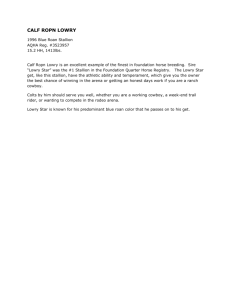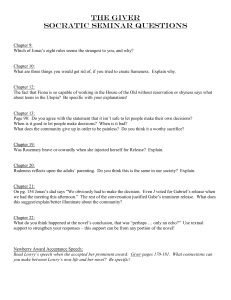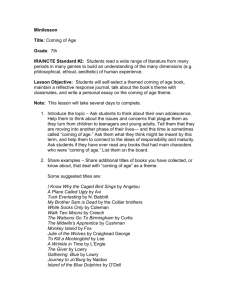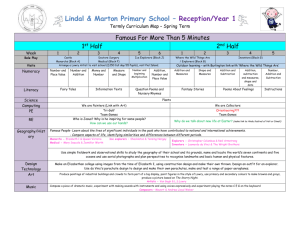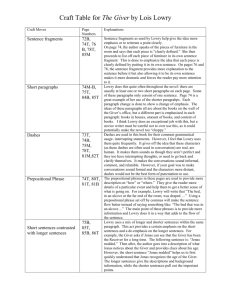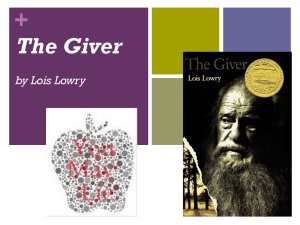The Lowry Worksheets for Teachers
advertisement
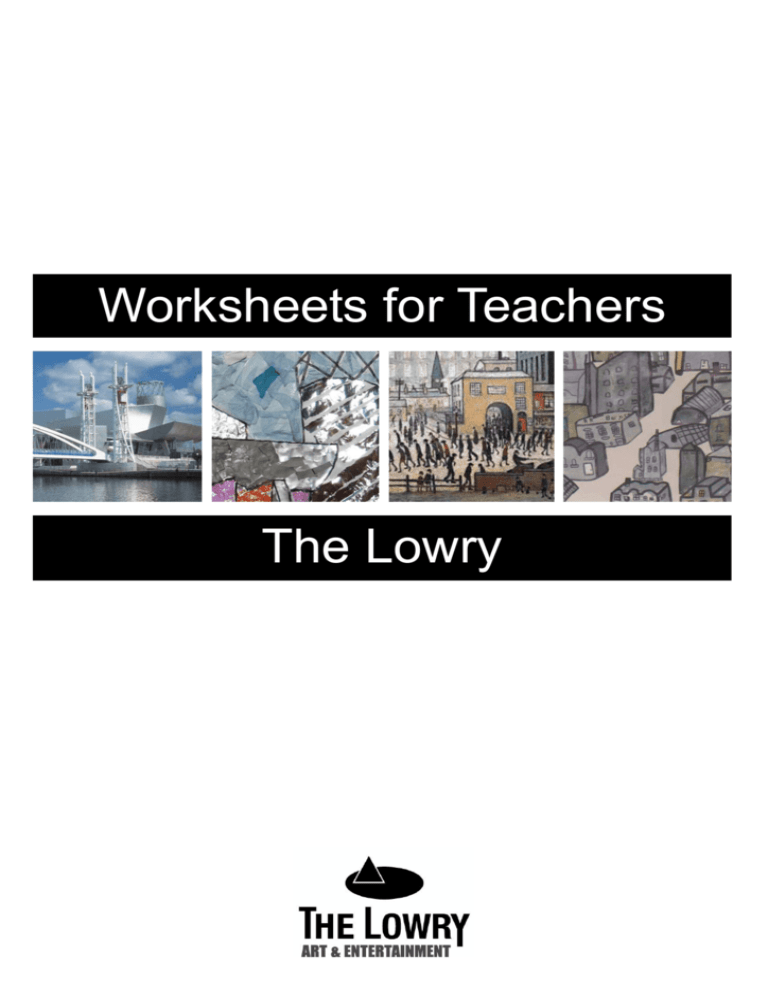
Worksheets for Teachers The Lowry Worksheets LS Lowry Worksheets for Primary & Secondary Pupils The following pages contain worksheets for you to use with your class. They can be photocopied for each person or adapted to your needs. They can be used in the classroom with information from the teachers pack or on a school visit to the galleries with information taken from the artworks themselves. Additional paper will be required to complete some of the activities. Further ideas can be found on the last page. We welcome feedback about these worksheets, and would like to hear any comments that you have about your experience, suggestions for developing activities or making a visit to The Lowry even better. If you would like further information or a teachers’ resource pack to accompany these worksheets please visit www.thelowry.com/education or call 0161 876 2086. To book a visit please contact group bookings on 0870 220 2003. Draw a line two thirds of the way up - this will be your roof. On another piece of paper draw a long rectangle and divide it into five smaller rectangles. This will make up your terrace of five houses. 1)Find some examples of terraced houses in Lowry’s paintings, look at Industrial Landscape, 1953. 2/3 1/3 Now draw in three windows, one next to the door and two above. The door should be to one side of the house. 2) Next you need to draw your house door. Where is the door on a terrace house? Is it to the side or is it in the middle? Roofs are made from tiles. Draw in the details of the lintels and the window ledges they should be wider than the windows. or terracotta tiles. They can be either slate tiles 4) The next step is to draw in the roofs. What are roofs made from? 3) The next house is a mirror image of the first house. It is symmetrical. 5)The last step to finish off your Lowry terraced houses is to add ridge tiles. These are tiles that sit on the top of the roof. See the different types of ridge tiles below. Try and draw your tiles without taking your pencil off the page! Now add colour. Lowry Landscapes Primary: Drawing a Lowry Landscape Lowry Landscapes Primary: Drawing an Industrial Landscape Create your own industrial landscape like those seen in Lowry’s paintings. Look at Coming from the Mill, 1930 or Industrial Landscape, 1953 to get an idea of what an industrial landscape might look like. 1) On a separate piece of paper draw a square about the size of your hand, add a rectangle and then a triangle on top of the rectangle. You now have a basic mill or factory building. 2) Now you need to add detail to your building. On the main square draw five rectangles across and three rectangles down, making fifteen in total. The rectangles will become the building’s windows. Try and make them evenly spaced and in line with each other. On the main rectangle add some bigger windows and doors for people to get into the building. You could add a clock or spire on the top of the rectangle tower. 3) Add detail to your detail. Draw lines to show the window panes onto your windows, these are called glazing bars. Add a small, long rectangle to the top and bottom of each window, like the picture on the right. 4) You should now have a detailed industrial building. If you want to add a chimney to your building then it should stand to the side or behind the building. It is very unusual for a chimney to come out of the roof like in a house - can you think why this is? 5) Draw another factory next to the one you have just drawn, use the same ideas but change the size of the shapes that you use, perhaps you could make the building longer or shorter, with more doors or windows, try a triangle roof or a taller tower. Draw a few more buildings to create your own Lowry industrial landscape. 6) Think about colouring in your landscape - what colours would you use? 7) Draw some people walking past your buildings - what are they doing and where are they going? How big do you think they would be? (They need to be able to get into the doors that you have drawn on your buildings.) Lowry Portraits Primary: Draw a Lowry Portrait Create your own Lowry portrait. Look at LS Lowry’s Head of a Man (with Red Eyes), 1938 or Portrait of Ann, 1957. Start off by drawing a line halfway through each of these shapes below. This will help you know where to put the different features on your Lowry face. 1) On a separate piece of paper draw an oval the size of an egg. Draw a faint line across the oval, half way up. 2) Think about where the eyes are on your face. Are they near the top, middle or bottom of your face? They are just above the halfway line that you drew on your oval. 3) What shape are your eyes? They are circles in the middle of a pointed oval shape. Practise drawing some eye shapes on this paper. Once you have practised the shape, add your eyes, just above the halfway line onto your face. 4) Now you need to add some ears - place the top of your ears in line with the top of your eyes, the halfway line should be in the middle of your ears. 5) The next thing to do is add your nose. Draw the bottom of your nose first. The bottom of your nose should line up with the bottom of your ears. 6) Add your eyebrows, one arch over each eye. Connect your eyebrows to your nose with a faint line (see the bottom picture on the left). 7) Draw on a pair of lips under the nose, halfway between the bottom of the nose and the bottom of the face. 8) Add some hair, look at how the hair comes down onto the forehead, it doesn’t sit on top of the head. It might be easier to draw in the hair parting first and then add the rest. Last of all! Add some colour to your portrait. 9) Now draw your face on the following page but BIGGER! Think about making things bigger and remember it has to be in proportion. Lowry Portraits Primary: Draw a Lowry Portrait Draw your Lowry portrait again (see previous page) - but bigger! Then add colour. Lowry Landscapes Secondary: Drawing an Industrial Landscape 1) Look at one of LS Lowry’s paintings of an industrial landscape, for example Coming From the Mill, 1930 or Industrial Landscape, 1953. Pick out a factory or mill building that you can see in the painting. On a separate piece of paper draw it about the size of your hand, in 2D, that means just the flat front of the building like the picture to the left. Add detail like windows and doors. 2) Make your building 3D by drawing lines that project at 45º from the right hand wall and the roof. Add details on the projecting side too, make sure to draw the top lines at 45º in line with the roof. The lines pointing downwards should be straight (these shapes are called parallelograms - a 4 sided shape that has 2 pairs of parallel sides). 45º 3) Think about spinning the building round by 90º. This means that the projecting side would now become the front of the building. How would it look? Draw the building, turned around, on your piece of paper. Draw the new front in 2D and then project a new side wall. Add detail. 4 ) Draw different kinds of industrial buildings, make them into 3D buildings and cluster them together to create a busy industrial Lowry landscape. Now add colours to your buildings, look at the colours that LS Lowry used in his paintings, they are quite dark and muddy colours, against a white background. Lowry only ever used 5 colours mixed together. They were flake white, ivory black, vermillion (red), Prussian blue and yellow ochre. Add small scurrying figures to finish off your Lowry landscape. Lowry Portraits Secondary: Drawing Figures in 360º Look at the three figures below. It is the same figure drawn from three different angles, side, back and front. Look at the proportions of the body. Where does the halfway line fall on the figures? What proportion of a figure is made up of the head? What proportion of the body do the legs make up? Are these proportions more or less than you thought? Think about where the arms stop on the body, are they shorter or longer than you expected? It is important to study real people when you are learning to draw figures. Do some quick sketches of people in your class, sitting, standing or passing by, think about the proportions of your subjects. Spend no more than 2 minutes quickly drawing each person, getting a real likeness, with the correct proportions. Lowry Portraits Secondary: Draw a Lowry Character in 360º Side Front Back Use the boxes below to draw a figure from a painting or drawing by LS Lowry, pick a person out of a crowd scene, like Coming From the Mill, 1930 or create a body to go with one of Lowry’s portraits, for example Head of Man (with Red Eyes) 1938 or Portrait of Ann, 1957. Make sure that the basic dimensions of the body are in proportion, (see previous page), the head should make up only one eighth of the whole body. Line up the shoulders, hands, knees and other features across the three drawings, that can be seen from side, front and back. Further Ideas Primary Landscapes Look at page 3 and ask each pupil to create their own row of terraced houses. Look at Lowry’s use of colours (see the Teachers’ Resource Pack) and paint them in the same style. Once you have painted them and they are dry ask the children to outline the houses and ALL their details with a black felt tip. Look at page 4 and ask your class to draw their own factory or mill building. Paint and outline these in the same way as the terraced houses. Glue the houses and factories (they can overlap!) on a large sheet of white paper to create a ‘neighbourhood’. You could leave spaces for roads or parks and paint these in if you like. Add Lowry style figures walking past and you have recreated your own Lowry landscape to display in your classroom. Portraits Look at pages 5 and 6. Ask each pupil to create a big, A4 sized self-portrait in the style of LS Lowry. Paint them in Lowry colours and cut them out. Go a step bigger and create the portraits to each fit in a square 50 x 50 cm. Paint them and cut them out. The effect of the large self-portraits being displayed together will be brilliant! Secondary Landscapes Look at page 7. Ask each pupil to create their 3D industrial building. Look at Lowry’s use of colours (see the Teachers’ Resource Pack) and paint them in the same style and colours, using acrylic paint. You could restrict the colour palette (eg. just use blue and red) to give a uniform feel to the work. Once they are dry ask the pupils to outline the houses and ALL their details with a black marker pen. Cut out each building and glue them together on a large piece of white paper, creating your own Lowry landscape. Portraits Look at page 8. Ask each pupil to follow the instructions to draw a Lowry figure in 360º. Get into groups of four or five and work up one of their pieces to a large-scale (A1 or larger), three figure drawing. Paint it as a group using acrylics and work into the paint, scraping away with palette knives or the end of a paintbrush, to give texture and depth, like Lowry did (see the Teachers’ Resource Pack).
